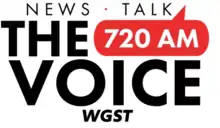WGST (AM)
WGST (720 kHz) is a commercial AM radio station licensed to Hogansville, Georgia, and serving West Central Georgia, including LaGrange and Newnan. It airs a talk radio format and is owned by iHeartMedia. Most programming on WGST is syndicated. It carries Premiere Networks shows from Rush Limbaugh, Sean Hannity and Glenn Beck. From the Salem Radio Network it carries Hugh Hewitt and Larry Elder. On weekends, sports programming from the Fox Sports Radio Network is heard. On weekdays, most hours begin with Fox News Radio.
 | |
| City | Hogansville, Georgia |
|---|---|
| Broadcast area | LaGrange - Newnan - West Central Georgia |
| Frequency | 720 kHz |
| Branding | 720 The Voice |
| Slogan | "The Voice of Midwest Georgia" |
| Programming | |
| Format | Talk |
| Affiliations | Premiere Networks Salem Radio Network Fox News Radio Fox Sports Radio |
| Ownership | |
| Owner | iHeartMedia (iHM Licenses, LLC) |
| WBIN, WBZW, WBZY, WCOH, WMGP, WRDG, WUBL, WWPW | |
| History | |
First air date | August 12, 1985 |
Former call signs | WMXY (1984–1999) WGSE (1999–2003) WVCC (2003–2020) |
Call sign meaning | "Georgia School of Technology", now Georgia Tech; founders of WGST (920 AM), now WGKA |
| Technical information | |
Licensing authority | FCC |
| Facility ID | 39620 |
| Class | D |
| Power | 7,970 watts daytime only |
Transmitter coordinates | 33°3′54.00″N 84°57′23.00″W |
| Links | |
Public license information | Profile LMS |
| Webcast | Listen Live |
| Website | 720thevoice |
WGST is powered at 7,970 watts, using a non-directional antenna. But because it shares AM 720, the same frequency as "clear channel" station WGN in Chicago, WGST is a daytimer, required to be off the air at night when AM radio waves travel farther.
History
The station was assigned the WMXY call sign on September 18, 1984;[1] it signed on August 12, 1985,[2] owned by Tharpe Communications and programming an urban contemporary format.[3] Tharpe sold the station to T. Wood and Associates for $5,000 in 1991; L.A. Wood was a principal of both companies.[4] Two years later, WMXY and its FM sister station, WEIZ, were sold to Magnolia Broadcasting for $200,000.[5] Magnolia sold the stations to First Georgia Broadcasting, owner of WKZJ in Greenville, for $145,000 in 1995;[6] the following year, First Georgia sold WVCC and what had become WZLG to Janz Broadcasting for $510,000.[7]
Janz Broadcasting sold WMXY and WZLG to Radio LaGrange for $975,000 in 1997, with a local marketing agreement commencing on December 1; Radio LaGrange's principals owned WCOH in Newnan and WMKJ in Peachtree City.[8] Jacor Communications announced a $4.4 million purchase of all four stations in January 1999;[9] Jacor was itself acquired by Clear Channel Communications (now iHeartMedia) a few months later.[2][10] WMXY changed its call sign to WGSE on July 12, 1999,[1] accompanied by a switch to a news/talk format;[11] the previous call sign was moved to WKBN-FM in Youngstown, Ohio.[12] The call sign was changed to WVCC on December 22, 2003, and to WGST on July 13, 2020.[1]
References
- "WGST Call Sign History". United States Federal Communications Commission, audio division.
- Broadcasting & Cable Yearbook 2010 page D-164
- Broadcasting Cablecasting Yearbook 1986 (PDF). 1986. p. B-75. Retrieved July 14, 2020.
- "For the Record" (PDF). Broadcasting. August 12, 1991. p. 56. Retrieved July 14, 2020.
- "Broadcasting Partners Gets Motown Duopoly With $40 Million For WMTG & WNIC" (PDF). Radio & Records. November 26, 1993. pp. 6–10. Retrieved July 14, 2020.
- "EZ Communications Creates Kansas City Duopoly For $35 Million" (PDF). Radio & Records. January 13, 1995. pp. 6–8. Retrieved July 14, 2020.
- "Clear Channel Claims Heftel In $275 Million Stock Sale" (PDF). Radio & Records. June 7, 1996. pp. 6–8. Retrieved July 14, 2020.
- "Elsewhere" (PDF). The M Street Journal. p. 9. Retrieved July 14, 2020.
- "Jacor expands into Georgia with four new stations". Cincinnati Business Courier. January 5, 1999. Retrieved July 14, 2020.
- "Closings Galore" (PDF). The M Street Journal. May 5, 1999. p. 1. Retrieved July 14, 2020.
- "Format Changes & Updates" (PDF). The M Street Journal. August 11, 1999. p. 1. Retrieved July 14, 2020.
- "Call Letter Changes" (PDF). The M Street Journal. July 28, 1999. p. 4. Retrieved July 14, 2020.
External links
- WGST in the FCC's AM station database
- WGST on Radio-Locator
- WGST in Nielsen Audio's AM station database